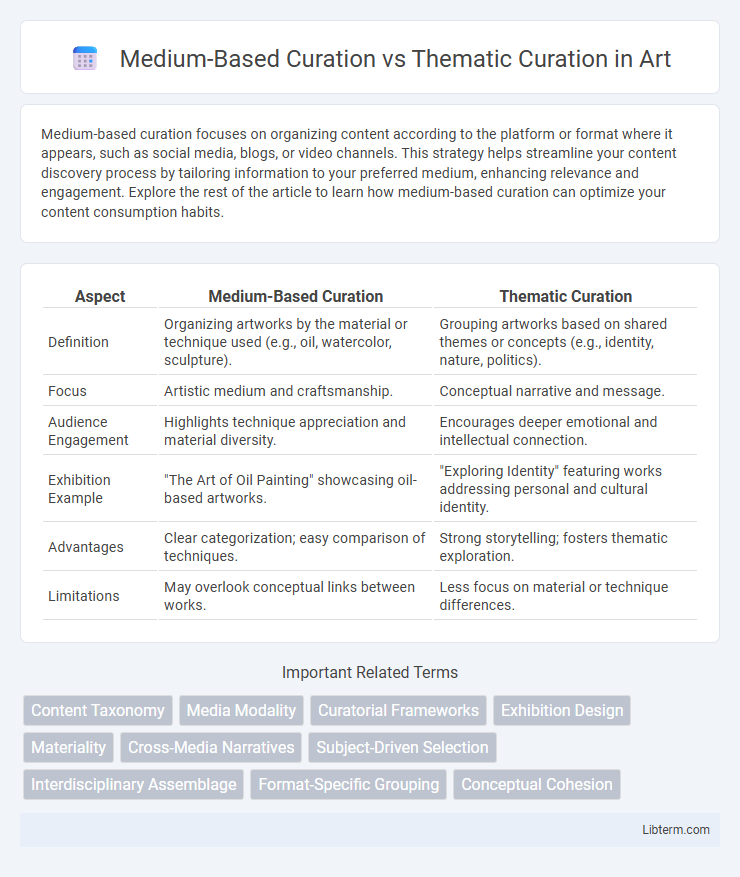Medium-based curation focuses on organizing content according to the platform or format where it appears, such as social media, blogs, or video channels. This strategy helps streamline your content discovery process by tailoring information to your preferred medium, enhancing relevance and engagement. Explore the rest of the article to learn how medium-based curation can optimize your content consumption habits.
Table of Comparison
| Aspect | Medium-Based Curation | Thematic Curation |
|---|---|---|
| Definition | Organizing artworks by the material or technique used (e.g., oil, watercolor, sculpture). | Grouping artworks based on shared themes or concepts (e.g., identity, nature, politics). |
| Focus | Artistic medium and craftsmanship. | Conceptual narrative and message. |
| Audience Engagement | Highlights technique appreciation and material diversity. | Encourages deeper emotional and intellectual connection. |
| Exhibition Example | "The Art of Oil Painting" showcasing oil-based artworks. | "Exploring Identity" featuring works addressing personal and cultural identity. |
| Advantages | Clear categorization; easy comparison of techniques. | Strong storytelling; fosters thematic exploration. |
| Limitations | May overlook conceptual links between works. | Less focus on material or technique differences. |
Introduction to Art Curation Approaches
Medium-based curation organizes artworks by the materials or techniques used, such as painting, sculpture, or digital media, highlighting the distinct expressive qualities of each medium. Thematic curation groups works around central ideas or narratives, emphasizing conceptual connections regardless of medium, which fosters diverse dialogues within the exhibition space. Both approaches shape audience engagement by structuring the visual experience differently, catering to either material specificity or thematic exploration in art presentation.
Defining Medium-Based Curation
Medium-Based Curation involves organizing content according to the format or platform, such as videos, podcasts, articles, or images, enabling users to efficiently locate specific types of media. This approach helps streamline content discovery by prioritizing the medium through which information is delivered rather than the topical theme. By contrast, thematic curation categorizes content based on specific subjects or themes, focusing on the relevance of the content topic rather than its delivery format.
Understanding Thematic Curation
Thematic curation organizes content around specific themes or topics, enabling deeper exploration and cohesive storytelling that aligns with audience interests. Unlike medium-based curation, which sorts content by format such as video or articles, thematic curation enhances user engagement by creating meaningful connections across diverse media types within a unified subject. This approach improves content discoverability and relevance, leading to a more immersive and targeted user experience.
Historical Evolution of Curation Methods
Medium-based curation historically prioritized categorizing content by format, such as print, audio, or digital, reflecting technological advancements and the rise of new media platforms. Thematic curation evolved to organize content by subject matter or audience interest, enabling deeper contextual relevance and personalized experiences. This shift mirrors the increasing emphasis on user engagement and the demand for curated content that aligns with specific narratives or cultural trends.
Key Differences Between Medium-Based and Thematic Curation
Medium-based curation organizes content primarily by the format or platform, such as video, podcasts, or articles, enabling audiences to engage with their preferred media type. Thematic curation categorizes content around specific topics, ideas, or narratives, providing a cohesive experience centered on subject matter irrespective of format. This distinction affects user engagement strategies by targeting either consumption preferences or interest-driven exploration.
Advantages of Medium-Based Curation
Medium-based curation leverages specific content formats like videos, podcasts, or articles to target audiences with preferred media consumption habits, enhancing engagement and user satisfaction. This approach allows curators to specialize in optimizing content delivery tailored to the unique dynamics and technical features of a particular medium, resulting in higher retention rates. By focusing on medium-centric platforms, medium-based curation benefits from streamlined content management and easier integration with platform-specific algorithms, boosting discoverability and relevance.
Benefits of Thematic Curation
Thematic curation enhances content discoverability by organizing information around specific topics or themes, leading to more relevant and focused user experiences. This approach fosters deeper engagement and retention by appealing directly to users' interests and needs, rather than merely sorting content by medium. Thematic curation also supports better SEO performance by targeting niche keywords and creating well-structured, contextually rich content hubs.
Challenges Faced in Each Curation Strategy
Medium-based curation faces challenges such as limited audience reach due to platform-specific content preferences and difficulties in maintaining content diversity across different media formats. Thematic curation struggles with ensuring relevance and coherence when aggregating diverse content types under a single theme, often encountering issues in balancing depth and breadth of information. Both strategies require continuous adaptation to evolving user interests and content availability to remain effective.
Case Studies: Medium-Based vs. Thematic Exhibitions
Case studies of medium-based curation highlight exhibitions focused on single artistic mediums, such as sculpture or photography, emphasizing technical mastery and material exploration. Thematic curation case studies reveal exhibitions centered around concepts or narratives, uniting diverse media to convey cohesive stories or address social issues. Comparing these approaches illustrates how medium-based exhibitions prioritize craftsmanship, while thematic exhibitions foster interdisciplinary dialogues and broader audience engagement.
Choosing the Right Curation Approach for Your Exhibition
Medium-Based Curation emphasizes organizing artworks according to their material or technique, such as painting, sculpture, or digital media, allowing visitors to explore the evolution and variations within a specific medium. Thematic Curation groups works around central ideas, narratives, or concepts, fostering deeper engagement with shared cultural, social, or historical contexts. Selecting the right curation approach depends on the exhibition's objectives, target audience, and the collection's strengths, as medium-based layouts highlight technical diversity while thematic arrangements promote interpretative storytelling.
Medium-Based Curation Infographic

 libterm.com
libterm.com